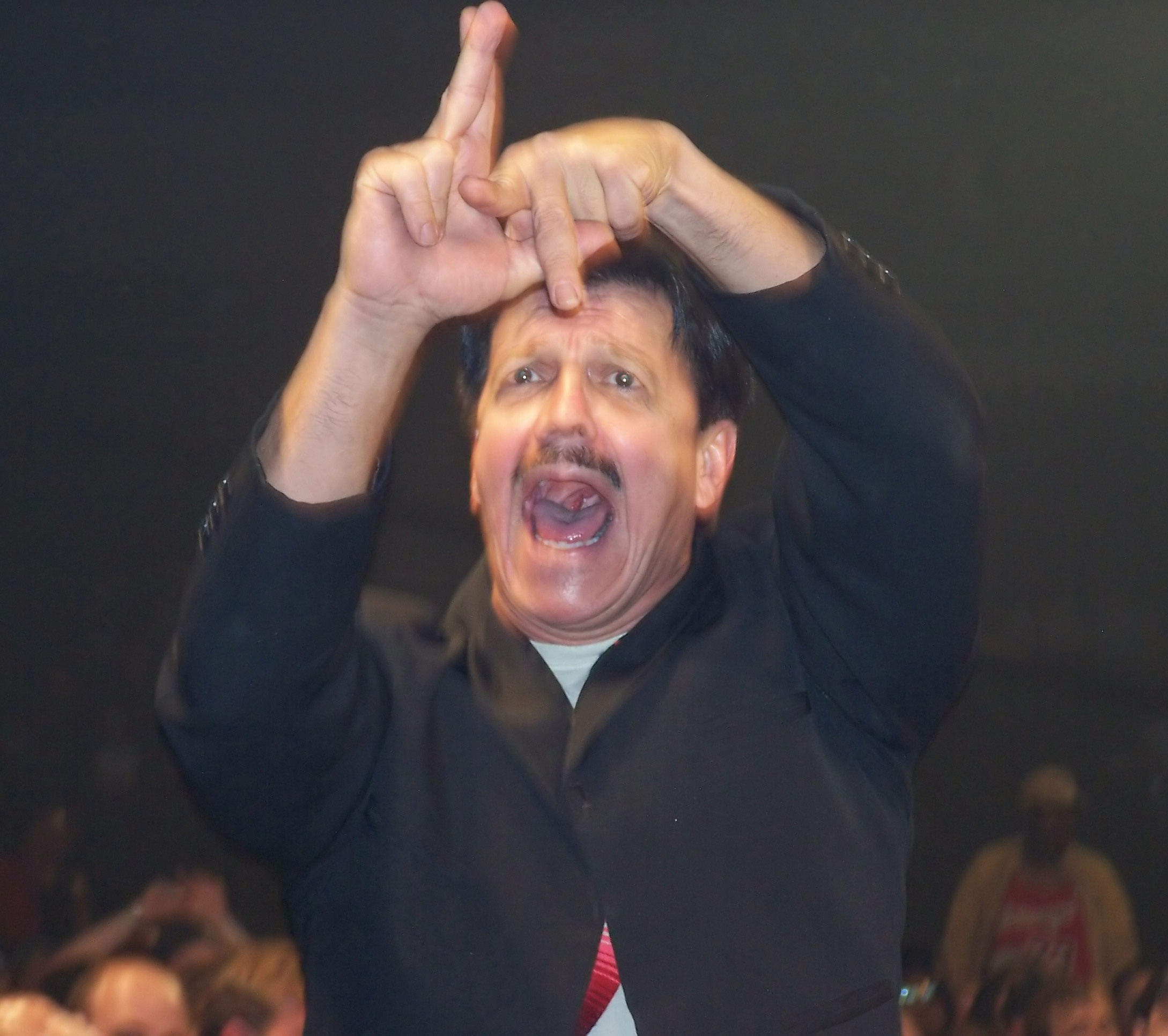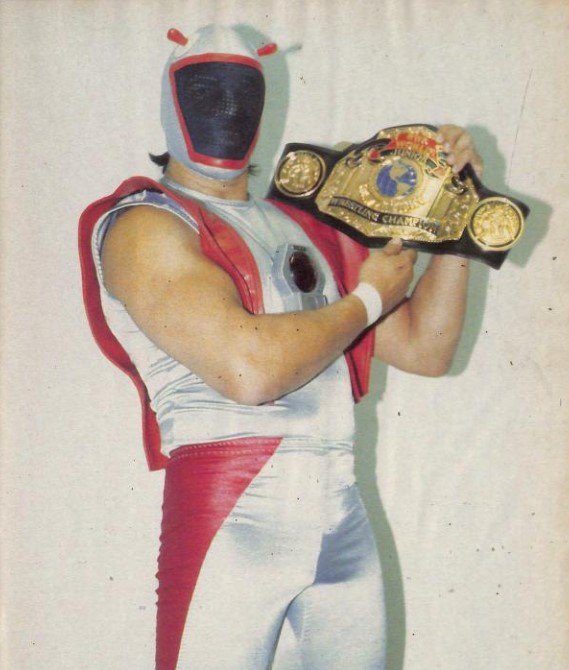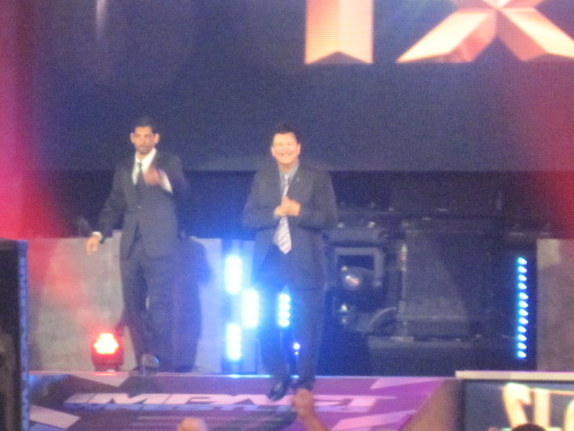1. Overview

Héctor Manuel Guerrero Llanes, born October 1, 1954, is a Mexican American former professional wrestler and commentator. He is a prominent member of the renowned Guerrero family, a legendary dynasty in professional wrestling. His father, Gory Guerrero, his brothers, Chavo, Mando Guerrero, and Eddie Guerrero, his nephew, Chavo Guerrero Jr., and his niece, Shaul Guerrero (also known as Raquel Diaz), are all professional wrestlers. Throughout his extensive career, Guerrero wrestled for most major North American wrestling promotions and notably served as a Spanish color commentator for Total Nonstop Action Wrestling (TNA) from 2007 to 2015. His known ring names include Héctor Guerrero, The Gobbledy Gooker, and Lazer-Tron. He stands at 5 in and weighed 228 lb (228 lb) during his career.
2. Early Life and Background
Héctor Guerrero's early life was shaped by his family's deep roots in professional wrestling and their relocation from Mexico to the United States.
2.1. Birth and Family
Héctor Manuel Guerrero Llanes was born on October 1, 1954, in Mexico City, Mexico. He is the son of the legendary professional wrestler Salvador "Gory" Guerrero Quesada, a foundational figure in both Mexican and American wrestling. Héctor is a distinguished member of the esteemed Guerrero family, which has significantly influenced the sport for generations. His extended family includes his uncle, Enrique Llanes, who was also a professional wrestler, as well as his brothers, Chavo, Mando Guerrero, and Eddie Guerrero, all of whom became prominent wrestlers. His nephew, Chavo Guerrero Jr., and niece, Shaul Guerrero (also known as Raquel Diaz), have also pursued careers in professional wrestling. Guerrero identifies as Christian.
2.2. Education and Early Activities
When Héctor Guerrero was young, his family relocated from Mexico City to El Paso, Texas, in the United States, a city he is often billed from. He pursued higher education at the University of Texas at El Paso, where he successfully earned a bachelor's degree in physical education. His foundational training in wrestling began under the tutelage of his father, Gory Guerrero. Guerrero officially debuted as a professional wrestler in 1973. In the 1990s, after entering semi-retirement from full-time wrestling, he also served as a wrestling coach at a high school in El Paso, further contributing to the sport's development. He currently resides in Tampa, Florida.
3. Professional Wrestling Career
Héctor Guerrero's professional wrestling career began in 1973 and spanned over four decades, seeing him compete across numerous promotions and adopt various personas, including a highly controversial one in the World Wrestling Federation.
3.1. Early Career (1973-1980)
Héctor Guerrero began his professional wrestling career in 1973, primarily wrestling in California. During these early years, he often formed tag teams with his brothers, Chavo Guerrero Sr. and Mando Guerrero. From the late 1970s, he became a prominent figure in NWA Hollywood Wrestling in Los Angeles, California, a territory also favored by his brother Chavo.
On January 13, 1978, teaming with Chavo, he captured the NWA Americas Tag Team Championship by defeating Black Gordman and El Golias. Just a month later, on February 10, 1978, he defeated the Masked Canadian (who was Roddy Piper) to claim the NWA Americas Heavyweight Championship. On the same date in 1978, he emerged victorious in the annual New Year's battle royal held in the region, outlasting notable competitors such as Chavo, the Masked Canadian, André the Giant, Tatsumi Fujinami, Ron Bass, Dean Ho, Victor Rivera, Moondog Main, Yasu Fuji, Butcher Brannigan, and Dominic DeNucci.
In January 1979, Guerrero made his first tour of Japan with New Japan Pro-Wrestling, where he engaged in competitive matches against Tatsumi Fujinami and performed alongside veteran wrestlers like Bob Roop, Johnny Powers, and Kurt von Hess. He then extensively toured the Southern United States, including Tennessee, Oklahoma, and Florida, while maintaining a consistent presence in Los Angeles. On July 9, 1982, he and Mando Guerrero secured their sixth NWA Americas Tag Team Championship reign by defeating the Japanese duo of Mr. Toyo (a persona used by Rusher Kimura) and Mr. Go (a persona used by Ryuma Go).
3.2. National Wrestling Alliance (1980s)
Héctor Guerrero made his first appearance in All Japan Pro Wrestling in April 1983, where he challenged Atsushi Onita for the NWA International Junior Heavyweight Championship at the Tokyo Metropolitan Gymnasium. During this period, he also teamed with legendary wrestler Harley Race, competing against notable duos like the "Tsuru-Ryu Combo" (Jumbo Tsuruta and Genichiro Tenryu) and the team of Giant Baba and Ashura Hara.
On July 13, 1984, in Los Angeles, Guerrero was recognized as the new NWA World Junior Heavyweight Champion after the title had been vacated. The following month, in August 1984, he returned to All Japan Pro Wrestling with his brother Chavo to participate in the "World's Strongest Junior Tag League." They competed against teams such as Mighty Inoue & Gran Hamada, Atsushi Onita & Masanobu Fuchi, Magic Dragon (Haru Sonoda) & Ultra Seven (Masahiko Takasugi), and Fishman & Baby Face, ultimately vying for the final against Inoue & Hamada. Guerrero continued his activities in Florida, and on August 28, 1985, he defeated Jesse Barr to win the NWA Florida Heavyweight Championship.

In 1986, Guerrero joined Jim Crockett Promotions within the NWA Mid-Atlantic territory. He initially formed a tag team with Manny Fernandez, known as "The Latin Connection." However, Fernandez later turned on him to align with Rick Rude and Paul Jones. Following this, Guerrero adopted the masked persona of **Lazer-Tron**. As Lazer-Tron, he utilized a high-flying, aerial wrestling style that garnered significant support, particularly from younger fans. On March 7, 1987, he once again captured the NWA World Junior Heavyweight Championship. He also teamed with the popular Jimmy Valiant and engaged in a feud with The New Breed during his time in the mid-card scene. He also feuded with Denny Brown for the NWA World Junior Heavyweight Championship.
3.3. American Wrestling Association (1980s)
After his tenure with the NWA, Héctor Guerrero transitioned to the American Wrestling Association (AWA). On October 19, 1987, in Memphis, Tennessee, he partnered with **Dr. D** (also known as Carl Kovac) to defeat Jerry Lawler and Bill Dundee and capture the AWA World Tag Team Championship. This marked a significant achievement for Guerrero in the late 1980s.
3.4. World Wrestling Federation (1990, 2001)
In 1990, Héctor Guerrero made an infamous appearance in the World Wrestling Federation (WWF) at Survivor Series (1990). He performed under the controversial gimmick of **The Gobbledy Gooker**, donning an elaborate turkey costume. The character was introduced by "hatching" from an oversized egg that had been heavily promoted and displayed at WWF events for months prior.
The audience reaction to The Gobbledy Gooker was overwhelmingly negative, with fans loudly booing as Guerrero, in costume, danced in the ring alongside announcer "Mean" Gene Okerlund. Despite the efforts of play-by-play commentators Gorilla Monsoon and "Rowdy" Roddy Piper to generate enthusiasm, the gimmick failed to connect with the crowd. The character made only a handful of subsequent appearances in taped promotional clips, including some with Koko B. Ware and The Bushwhackers, before being quickly shelved from television. Years later, the wrestling website WrestleCrap would coin the "Gooker Award," annually presented to the worst gimmicks, storylines, or events in professional wrestling, in honor of this notable flop. According to Pat Patterson, the idea for The Gobbledy Gooker originated directly from Vince McMahon.
After being shelved for over a decade, the WWF, having rebranded as WWE, began to acknowledge and even mock some of its past mistakes. The Gobbledy Gooker was briefly revived for WrestleMania X-Seven on April 1, 2001. Guerrero once again wore the costume, which was notably different from the original, and participated in the "Gimmick Battle Royal." This match was unique for being populated entirely by older, often retired wrestlers with outlandish gimmicks, as well as one-off oddities like the Gooker. Despite the on-screen graphic misspelling the character's name as "Gobbly Gooker," Héctor Guerrero again portrayed the role, being the second participant eliminated in the match. When Gene Okerlund was inducted into the WWE Hall of Fame in 2006, he famously recalled some of his interviews and openly acknowledged that it was Héctor Guerrero behind the costume, playfully stating, "Héctor, we had a lot of fun, but all of this is forgotten."
3.5. Various Promotions (1992-1998)
Following his initial WWF appearance, Héctor Guerrero continued to make sporadic but notable appearances for various wrestling organizations. After entering semi-retirement in the 1990s and coaching wrestling in El Paso, he still maintained an active presence in the ring.
He had a brief stint in Jim Cornette's Smoky Mountain Wrestling (SMW) between 1992 and 1993. In 1995, Guerrero appeared with the Philadelphia, Pennsylvania-based Extreme Championship Wrestling (ECW), where he unsuccessfully challenged 2 Cold Scorpio for the ECW World Television Championship at the event Return of The Funker. He also wrestled for the American Wrestling Association (AWA), various NWA territories, Mid-South, and made appearances in Japan, among many other independent promotions over his long career spanning 45 years.
In July 1997, Guerrero appeared in World Championship Wrestling (WCW) to confront his brother Eddie Guerrero regarding his on-screen behavior. He wrestled Eddie and Dean Malenko during this period. Héctor departed WCW after losing a singles match to his brother on an episode of WCW Saturday Night. According to Eddie Guerrero's autobiography, Héctor's departure was due to his dissatisfaction with his treatment within the company. On May 22, 1998, Héctor Guerrero teamed with Eddie Guerrero to win the Pro Wrestling Federation (PWF) Tag Team Championship from an independent promotion based in North Carolina.
3.6. Total Nonstop Action Wrestling (2007-2015)

On March 1, 2007, Total Nonstop Action Wrestling (TNA) officially announced the hiring of Héctor Guerrero as their new Spanish color commentator. Shortly after, on March 8, 2007, TNA and the Hispanic Legacy Foundation jointly presented him with an award acknowledging his "achievements in the sport of professional wrestling."
On May 1, 2008, Guerrero accepted an on-screen offer from The Latin American Xchange (LAX) to become their new advisor and mentor. Under his management, LAX achieved significant success. On May 11, 2008, Guerrero guided LAX to three victories, which culminated in them winning the TNA World Tag Team Championship. During these matches, he actively interfered, first helping Homicide pin A.J. Styles, and then assisting in the removal of Johnny Devine from Team 3D's corner.
On the September 25, 2008, episode of TNA Impact!, Guerrero, Homicide, and Hernandez competed in a six-person "Loser's Manager Leaves Town" match against Beer Money, Inc. (Robert Roode, James Storm, and Jacqueline). The match concluded when Roode pinned Hernandez, a result that stripped Guerrero of his managing privileges for LAX.
Following his departure from LAX, Guerrero returned to his role as a Spanish color commentator. On the September 10, 2009, edition of TNA Impact!, he confronted Eric Young and other members of The World Elite during an in-ring promo, specifically when Young attempted to persuade Hernandez to join their faction. After an eight-year tenure with the company, Héctor Guerrero announced his official departure from TNA on Twitter on April 28, 2015. His profile was subsequently moved to TNA's Alumni roster. Since leaving TNA, Guerrero has established his own professional wrestling consulting company.
4. Personal Life
Héctor Guerrero is the son of the legendary professional wrestler Salvador "Gory" Guerrero Quesada and a prominent member of the esteemed Guerrero family. His extended family includes his uncle, Enrique Llanes, his brothers, Chavo, Mando Guerrero, and Eddie Guerrero, and his nephew, Chavo Guerrero Jr., and niece, Shaul Guerrero (also known as Raquel Diaz), all of whom have been involved in professional wrestling. Guerrero is married to his longtime sweetheart, Penny, and identifies as Christian.
In addition to his wrestling career, Guerrero also dedicated time to education. From 2002 to 2009, he worked as a physical education teacher at Mintz Elementary in Brandon, Florida. After his semi-retirement from active wrestling in the 1990s, he also served as a wrestling coach at a high school in El Paso, Texas. He currently resides in Tampa, Florida.
5. In-Ring Style and Techniques
Héctor Guerrero was recognized for a versatile in-ring style that combined traditional wrestling techniques with high-flying maneuvers, especially prominent during his time as Lazer-Tron. His signature moves and techniques included:
- Butterfly suplex
- Rolling cradle (often dubbed the "Rolling Guerrero Cradle")
- Tope suicida
- Flying crossbody
- Dropkick
- Three Amigos (a signature series of three consecutive suplexes, particularly popularized by his brother Eddie Guerrero)
6. Championships and Accomplishments
Héctor Guerrero has achieved numerous championships and accolades throughout his professional wrestling career.
| Accomplishment | Number of Reigns / Ranking | With |
|---|---|---|
| American Wrestling Association | ||
| AWA World Tag Team Championship | 1 time | Dr. D |
| California Pro Wrestling | ||
| CPW California Championship | 1 time | |
| Championship Wrestling from Florida | ||
| NWA Florida Heavyweight Championship | 1 time | |
| NWA Florida Junior Heavyweight Championship | 1 time | |
| NWA United States Tag Team Championship (Florida version) | 1 time | Chavo Guerrero |
| Continental Wrestling Association | ||
| AWA Southern Tag Team Championship | 1 time | Steve Regal |
| Jim Crockett Promotions | ||
| NWA World Junior Heavyweight Championship | 2 times | |
| NWA Hollywood Wrestling | ||
| NWA Americas Heavyweight Championship | 2 times | |
| NWA Americas Tag Team Championship | 6 times | Chavo Guerrero (1), Black Gordman (1), Barry Orton (1), Mando Guerrero (3) |
| NWA Tri-State | ||
| NWA Tri-State Tag Team Championship | 1 time | Ron Sexton |
| Pro Wrestling Federation | ||
| PWF Tag Team Championship | 1 time | Eddie Guerrero |
| Pro Wrestling Illustrated | ||
| Ranked in PWI 500 | #423 of the top 500 singles wrestlers of the PWI Years in 2003 | |
| Western States Alliance | ||
| WSA Western States Tag Team Championship | 1 time | Mando Guerrero |
| World Organization of Wrestling | ||
| WOW Heavyweight Championship | 1 time | |
| World Wrestling Council | ||
| WWC Puerto Rico Heavyweight Championship | 1 time | |
| Wrestling Observer Newsletter awards | ||
| Worst Gimmick | 1990 | As The Gobbledy Gooker |
7. Legacy and Evaluation
Héctor Guerrero's career stands as a testament to his skill and adaptability within professional wrestling, embodying significant positive contributions to the industry. However, it also includes a highly memorable and widely criticized moment that became a permanent part of wrestling lore.
7.1. Critical Reception and Controversies
Héctor Guerrero's career, while marked by numerous in-ring achievements, also featured a highly notable and widely criticized incident: his portrayal of **The Gobbledy Gooker** in the World Wrestling Federation (WWF). Introduced at Survivor Series (1990), the character, a turkey in a costume, received an overwhelmingly negative reception from the audience. Fans loudly booed the segment, and the gimmick was quickly abandoned from WWF programming after only a few promotional appearances. The notoriety of this character led to the establishment of the "Gooker Award" by WrestleCrap, an annual accolade for the worst gimmicks or storylines in professional wrestling, cementing its place as one of the most infamously bad creative decisions in wrestling history. Pat Patterson later confirmed that the idea for The Gobbledy Gooker originated directly from Vince McMahon.
Another point of contention in his career was his departure from World Championship Wrestling (WCW) in 1997. His brother, Eddie Guerrero, noted in his autobiography that Héctor left the promotion because he was unhappy with the way he was being treated, suggesting underlying issues with management or his role within the company.
7.2. Impact and Positive Contributions
Despite the occasional misstep, Héctor Guerrero's career stands as a testament to his skill and adaptability within professional wrestling, embodying significant positive contributions to the industry. As a key member of the legendary Guerrero family, one of the most celebrated and influential wrestling dynasties, he carried on a legacy of in-ring excellence and showmanship.
Guerrero's career spanned decades and numerous major promotions across North America, including the National Wrestling Alliance (NWA) territories, the American Wrestling Association (AWA), Extreme Championship Wrestling (ECW), and World Championship Wrestling (WCW). His versatility was evident in his ability to transition from a technical in-ring performer to a popular high-flyer under the masked persona of **Lazer-Tron**, a gimmick that garnered significant fan support, particularly from children. He also made notable appearances in Japan, competing for both New Japan Pro-Wrestling and All Japan Pro Wrestling, showcasing his talents on an international stage.
Later in his career, Guerrero transitioned into a crucial off-screen and on-screen role in Total Nonstop Action Wrestling (TNA). From 2007 to 2015, he served as a respected Spanish color commentator, providing valuable insights to a wider audience. His on-screen role as an advisor and manager for The Latin American Xchange (LAX) was particularly impactful, leading the group to capture the TNA World Tag Team Championship and enhancing their visibility. Even after his semi-retirement, Guerrero continued to contribute to wrestling, including coaching at a high school and later establishing his own professional wrestling consulting company, further cementing his enduring commitment to the sport. His longevity, diverse roles, and connection to a legendary family ensure his place in wrestling history.